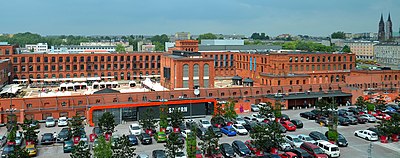This is an old revision of this page, as edited by Keizers (talk | contribs) at 16:24, 1 August 2020 (→Versus North American usage: add line break before wide image). The present address (URL) is a permanent link to this revision, which may differ significantly from the current revision.
Revision as of 16:24, 1 August 2020 by Keizers (talk | contribs) (→Versus North American usage: add line break before wide image)(diff) ← Previous revision | Latest revision (diff) | Newer revision → (diff) Unenclosed shopping areaThis article is about open-air shopping centers in Europe with mostly retail warehouse (big box) tenants. For the equivalent in North America, see power center (retail) and neighborhood shopping center.

A retail park , in the United Kingdom and Europe, is a type of shopping centre found on the fringes of most large towns and cities in the United Kingdom, and some (but not all) other European countries. In Europe, any shopping center with mostly "retail warehouse units" (UK terminology; in the US the term is "big-box stores"/superstores), 5000 sqm or larger is a retail park, according to the leading real estate company Cushman & Wakefield.
Positioning
Retail parks generally are located in highly accessible locations and are aimed at households owning a car, though there are often also bus services. They are an alternative to city centre shopping districts. Such developments have been encouraged by cheaper, more affordable land on the outskirts of towns and cities, and with loose planning controls in a number of Enterprise Zones, making planning and development very easy. In recent years, in many areas across the UK, planning controls have been tightened to preserve the countryside. This has made it more difficult for such developments to proceed, resulting in many smaller, more compact retail parks, sometimes consisting of only three or four stores being built on former brownfield sites. There are also environmental disadvantages to large retail parks on the rural fringe, including the increased traffic and pollution that occurs during access.
Typical tenants
Typically retail parks host a range of chain stores, including furniture, clothes or footwear superstores, electrical stores, carpet and others - and the anchor tenant is usually a supermarket. Owing to their out-of-town sites, abundance of free parking and proximity to major roads, retail parks are often easier to reach than central shopping areas, and as a result town centres are less attractive to retailers.
In Continental Europe
Retail parks have been growing in Continental Europe: according to Cushman & Wakefield, who defines a retail park as an open-air centre with more than 5,000 sq. m. of retail space, total retail space in retail parks in Europe was predicted to be around 40 million sq. m. at the end of 2017. The amount of floor space in retail parks increased by 836,000 square meters in 2015, and 1.3 million square metres in 2016. France accounted for 54% of the new retail space in Western Europe, followed by Britain at 17% and Italy at 10%. At 70,000 sq. m., the "Steel" retail park in Saint-Étienne, France was cited as the largest planned project at that time.
Versus North American usage
See also: power center (retail), and, neighborhood shopping center, and, and strip mallIn the U.S., "retail park" is neither the common nor industry term. A shopping centre that in Europe is considered a retail park might fall into one of several categories in North American industry terms:
- Power centers: Even larger centers of 250,000 to 600,000 square feet (23,000 to 56,000 m) are considered power centers, typically anchored by category-killer big box stores (e.g. Best Buy) incl. discount department stores (e.g. Target) and wholesale clubs (e.g. Costco).
- Community centers: Slightly larger centers 125,000 to 400,000 square feet (11,600 to 37,200 m) with general merchandise or convenience- oriented offerings are termed as community centers or large neighborhood centers by the ICSC (International Council of Shopping Centers), who state that they typically have a "wider range of apparel and other soft goods offerings than neighborhood centers. The center is usually configured in a straight line as a strip, or may be laid out in an L or U shape, depending on the site and design."
- Strip malls: Open-air centers under 30,000 square feet (2,800 m) are generally considered strip malls.
 Kingsway West Retail Park in Dundee, Scotland. Typical layout with an anchor store - here a Tesco hypermarket, and large-format retailers, surrounding customer parking and traffic access.
Kingsway West Retail Park in Dundee, Scotland. Typical layout with an anchor store - here a Tesco hypermarket, and large-format retailers, surrounding customer parking and traffic access.
See also
- Big-box store (known as a "retail warehouse unit" in the industry in the U.K. and Europe)
- Power center (retail) (North America)
- Neighborhood shopping center (North America)
- Lifestyle center
- Festival marketplace
- Strip mall
- Types of retail outlets
References
- "European Retail Parks: What's Next". Cusman & Wakefield. Summer 2019.
{{cite journal}}: Cite journal requires|journal=(help) - "DEVELOPMENT OF RETAIL PARKS ACCELERATES THROUGHOUT EUROPE", Across: the European Placemaking Magazine, August 23, 2016
- Bromley, Rosemary D. F.; Thomas, Colin J. (24 May 1988). "Retail Parks: Spatial and Functional Integration of Retail Units in the Swansea Enterprise Zone". Transactions of the Institute of British Geographers. 13 (1): 4–18. doi:10.2307/622771. JSTOR 622771.
- Kollewe, Julia (16 April 2012). "Blow to UK high street as more retailers move out of town". the Guardian.
- "European Retail Parks: What's Next". Cusman & Wakefield. Summer 2019.
{{cite journal}}: Cite journal requires|journal=(help) - "DEVELOPMENT OF RETAIL PARKS ACCELERATES THROUGHOUT EUROPE", Across: the European Placemaking Magazine, August 23, 2016
- ^ (PDF). www.icsc.org. Retrieved 2020-05-16.
External links
- SmartCentres – includes photos of its developments